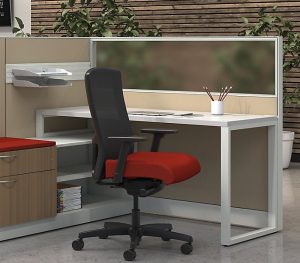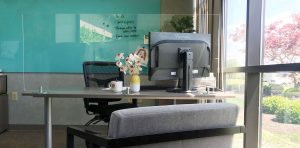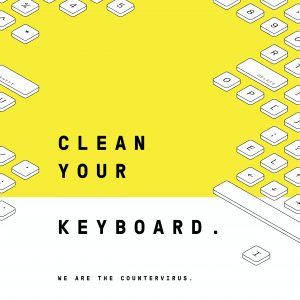
Do you have a reopening plan?
Five questions to get you started
It looks like Central Illinois is on track for a gradual reopening of most workplaces. That means thinking about what your new normal will look like. Planning for such unprecedented circumstances can feel overwhelming. Where do you start?
At Rogards, we’ve been hard at work during the stay-at-home period talking to local businesses about their plans and researching solutions. We’re also members of a buying group of other independent office supply dealers and we’ve been talking to them about what they’re hearing from businesses in their areas. That’s provided us with some recommendations on how you might start thinking about reopening your office.
1. Who are you bringing back to the office?
The first decision you’ll need to make is staffing. You may have been completely closed. Maybe your office has been closed, but people have been working from home. Or you’ve been partially open with staff taking turns being in the office. Now you’ll need to decide who will be returning to the office. There are many factors to consider:
- Does your current office layout offer sufficient space for social distancing if everyone is in the office?
- If you need to limit the number of staff in the office, how will you decide who comes in and who works from home?
- If you have staff currently working from home, can they continue to do that? How long do you expect to let people work from home?
- Do you have an official work from home policy? What will the rules be?
- If people will be working from home for an extended period of time, will you provide home office furniture or supplies? How will those items be ordered?
To use ourselves as an example, we were allowed to operate as usual throughout the stay-at-home order, but we decided it would be best to limit the number of staff in the office on a daily basis. Some of our people, like our delivery drivers, had to be here in order to do their jobs. Others, like our customer service and purchasing staff, were more efficient when working from the office so they also came in. But our sales team were already set up with laptops and could work from anywhere, so they stayed home. Our bookkeeper split her time, working from home some days and the office others.
Many companies are already saying that it might be a year or more before they ask people to come back to the office, if ever. And while that might not be practical for all businesses, it could be for many. Take a look at your staff. Does everyone need to be in the office every day? If people will be working from home on a permanent or semi-permanent basis, what will that look like for your business? Clearly phone and internet access will be necessary. Will you cover any of the cost? Will you provide them with furniture or supplies? How will you control what is purchased? We can help you set up approved item lists, order dollar limits, or approval chains to make ordering easy for off-site workers while still giving you some control over purchasing.
2. Do you need to make physical changes to your workspace?
Next, you’ll want to make sure that your staff will feel safe in their workplaces when they return to work. Do you need to make changes to your space to ensure you can follow current guidelines?
- Do you have staff that share offices? Do those offices need to be rearranged? For example, are any staff sitting face-to-face? Can the workstations be moved so they’re back-to-back?
- Do you need to add panels between workstations to provide more separation?
- Do you need to provide barriers to help protect any customer-facing staff (tellers, receptionists, etc)?
- What about your waiting and reception areas or conference and meeting rooms? Is there space for distancing?
- Is your lounge and conference furniture easily sanitized?
 In recent years, office design has moved away from individual cubicles and offices to more open, collaborative spaces. Your workplace may have spaces where team members sit next to each other or even face-to-face. What do you need to do to make these areas safer for your staff? Sometimes a simple rearranging of the space can work if you have sufficient room. If not, you may need to add some panel walls or other barriers. Panel walls come in many heights and are now available with frosted or clear glass, which is easy to wipe down daily and allows for light throughout the space so you don’t get that dreaded cubicle farm look. You can also get protective barriers in a number of styles, including hanging, free standing, clamp mounted, and surface mounted, so you can find one that works for any space. And the plexiglass is easy to disinfect. Most of our banking customers are getting protective screens for their tellers. Do you have any front line staff that might need protection?
In recent years, office design has moved away from individual cubicles and offices to more open, collaborative spaces. Your workplace may have spaces where team members sit next to each other or even face-to-face. What do you need to do to make these areas safer for your staff? Sometimes a simple rearranging of the space can work if you have sufficient room. If not, you may need to add some panel walls or other barriers. Panel walls come in many heights and are now available with frosted or clear glass, which is easy to wipe down daily and allows for light throughout the space so you don’t get that dreaded cubicle farm look. You can also get protective barriers in a number of styles, including hanging, free standing, clamp mounted, and surface mounted, so you can find one that works for any space. And the plexiglass is easy to disinfect. Most of our banking customers are getting protective screens for their tellers. Do you have any front line staff that might need protection?

Offices shouldn’t be your only concern. Don’t forget to take a look at your reception area and meeting rooms. Should you remove some chairs to make sure there’s enough space for social distancing? Do you need to set an occupancy limit on your meeting rooms? Can the spaces be easily sanitized after meetings? Tables are easy to clean, but what about the chairs? Fabric chairs can’t be wiped down as easily as vinyl. Do you need to replace chairs in highly trafficked areas?
3. How will you look after staff health and wellness?
Clearly you want to make sure that all of your employees are healthy and feel safe in the office. No one wants an outbreak at their workplace. What policies and guidelines can you put in place to help improve your chances of having a healthy work environment?
- How will you assess staff members’ health?
- How will you decide if/when someone needs to be sent home?
- Should you make changes to your sick leave/PT policy?
There’s no one good answer for health assessments. It will depend on the nature of your business. Some manufacturing plants and large employers are doing daily temperature checks. This may be necessary if your workspace or the nature of your work makes it difficult to maintain appropriate distance between employees. If you have a smaller workplace or mostly private offices, this may not be necessary. We’re asking our employees to self report. As each person returns to the office, they’re required to complete a short health questionnaire. If, at any point, their answers to any of the questions change, they must inform their coordinator and stay home until they’re healthy.
Your sick leave policy can also affect the health of your office. We all know that people come to work when they’re sick, often because they’ve run out of sick time or are afraid to use up their time. That’s not great under normal circumstances, but it’s an especially bad idea now. At worst, COVID-19 could spread throughout your workplace. At best, knowing there’s someone sick in the office can leave coworkers feeling unsafe and anxious. We made the decision to cover all sick time during the stay-at-home period rather than risk having someone come to work sick. What will your rules for sick time be?
4. How will you ensure a hygienic workplace?
Once you’ve opened your office, you’ll want to be sure that you’re doing everything you can to control the spread of germs. As we’ve discussed before, offices have lots of hidden germy spots and germs move from person to surfaces to person shockingly fast. What will you do to keep the spread under control?
- How will you keep your office sanitized throughout the day? Do you have facilities staff that can take this on or will you need to find others who can?
- Who will be in charge of cleaning what? Do you need to set a schedule or checklist to make sure that all areas are addressed?
- Do you need to add more handwashing or sanitizer stations to make sure people can keep their hands clean throughout the day?
- Do you need to make wipes and cleaners more easily available to all staff members so they can keep their areas sanitized?
If you have a dedicated facilities crew, this may be as easy as setting a schedule and assigning areas to a specific person or team. But if you have a smaller office without a daily cleaning crew you’ll have to make a plan. For example, our cleaning service only comes once a week so the daily sanitizing is up to us, and we’ve come up with a three-part plan. First, team members must wash their hands immediately each time they enter the building. Second, we’ve been cleaning high traffic areas, like our breakroom and conference room, after every use to keep those areas clean throughout the day. Third, we’ve assigned a team of three to wipe down all common areas (printer rooms, rest rooms, door handles and alarm keypads, etc) at the end of the day, and each employee is responsible for cleaning their own workspace at least once a day.
 How can you encourage people to keep it clean? Well, we added soap dispensers at all sinks throughout the building to make washing hands regularly easier. We’ve also put out extra wipes and/or spray cleaners in common areas throughout our building to make it convenient for everyone to clean their offices and shared spaces. Signs are also a great way to keep people thinking about cleanliness. The Illinois Department of Commerce and Economic Opportunity had created a number of health and directional signs, with messages for both employees and visitors, for free download. If you’re looking for more office-based reminders, local marketing firm SURFACE 51 has also created some signs available for free download.
How can you encourage people to keep it clean? Well, we added soap dispensers at all sinks throughout the building to make washing hands regularly easier. We’ve also put out extra wipes and/or spray cleaners in common areas throughout our building to make it convenient for everyone to clean their offices and shared spaces. Signs are also a great way to keep people thinking about cleanliness. The Illinois Department of Commerce and Economic Opportunity had created a number of health and directional signs, with messages for both employees and visitors, for free download. If you’re looking for more office-based reminders, local marketing firm SURFACE 51 has also created some signs available for free download.
5. What will your interactions with customers and clients look like?
You probably miss your customers and clients; we definitely miss ours. Inviting people into your workspace can also bring some risks. Have you weighed the pros and cons?
- Will you allow visitors into your workplace?
- Will you allow walk-in visits or by appointment only?
- What precautions will you take with visitors?
- Will you resume deliveries? If so, how will they be handled?
- Will you be visiting clients in their workplaces or homes? Will there by guidelines in place to help staff decide when visits are necessary?
For some of you, there’s no question here. Opening your business means opening for customers and clients. You can still be welcoming while looking after everyone’s health. Some of our clients are working with us to create hygiene stations at entrances with masks and gloves or hand sanitizer for visitors. Others are looking for social distancing floor decals to make it easier for visitors to keep appropriate distance. Some are adding signs reminding everyone to wear a mask and limiting the number of people allowed in at one time. Your needs will differ depending on the size of your business and the number of visitors you usually have.
We’ve decided to have our customers in by appointment only so we can better control the number of people in the building. Each visitor is asked to complete a short health questionnaire and is required to wear a mask when in the common areas of the building. Once they’ve moved to an office or conference room where social distancing can be observed, masks can be removed for easier conversation if both parties are comfortable doing so.
If you do deliveries or office/home visits, you’ll want to set guidelines for those as well. Are you ready to restart outside visits? What will your guidelines be? We’ve allowed our drivers to resume inside delivery if our customers allow it, but we’re still taking pictures as proof of delivery. We’ve also resumed furniture installations. Our install team is required wash or sanitize their hands at the beginning and end of each install and to wear a mask if asked to do so by the client.
This is by no means an exhaustive list, but we hope it give you some ideas for creating a reopening plan of your own. You can also visit the Illinois Department of Public Health’s Workplace Health and Safety Guidance page for more information. We’re excited to see our community get back to normal, even if that normal is a little different now. If there’s anything that we can do to help your business, please give us a call. We’re here to help.

